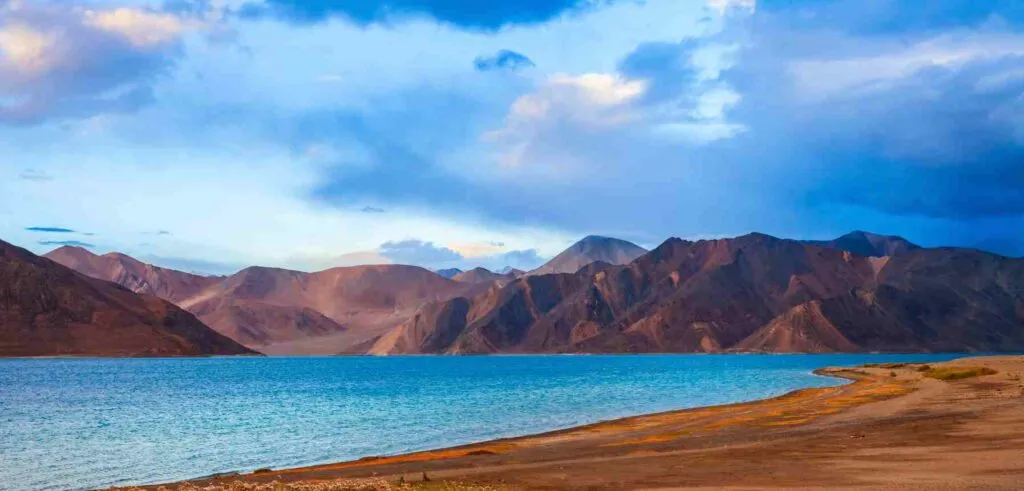
Ladakh’s Pangong Lake grabs attention like few places can. Stretching out in surreal blue, it feels dreamlike against the stark, high-altitude desert. Thanks to its cinematic debut in films and its popularity among visitors, Pangong Lake draws adventurous travelers and photography lovers year after year.
Spangmik Village: The Gateway to Pangong
Spangmik Village is perched on the western edge of the lake. You sense the welcome as soon as you arrive, with the village nestled between barren mountains and the colorful waters. Spangmik is the most accessible and popular base to explore Pangong, favored for its traditional homestays, friendly locals, and easy access to the lakeshore.
Walking along the lake here you’ll find the best spots to soak up sunrise or sunset. The water constantly changes color, offering unforgettable views you’ll want to photograph again and again. For a charming and comfortable stay with up-close lake views, you may want to check options like the Mystic Mountains Cottage near Spangmik.
Merak Village: Offbeat Tranquility
Just east of Spangmik lies Merak, a peaceful village tucked along a quiet curve of Pangong. Here, you trade crowds for solitude and untouched scenery. Merak is perfect if you’re looking for an authentic Ladakhi experience and a slower pace.
This area brims with birds and wildlife. On a clear morning, the mountains seem almost close enough to touch. Since fewer visitors reach Merak, it’s ideal for connecting with nature or joining a local family for traditional food. The journey there takes you along the shoreline, passing through smaller villages and rugged cliffs, detailed by travelers on forums like India Mike.
Camping at Pangong Lake: An Unforgettable Experience
Camping here is unlike anywhere else. Feel the chill in the air and the thrill in your chest as you pitch your tent right beside the shifting blue waters. Watching the stars above Pangong is magical—the clear, pollution-free skies show thousands of stars at night. Wake early, and you’ll catch a sunrise so breath-taking, it almost doesn’t look real.
Popular camps are set just outside Spangmik and offer easy access to the lake, comfortable tents, and simple meals. If you decide to camp in pangong lake, remember to follow eco-friendly tips: never leave trash, avoid single-use plastic, and respect wildlife.
Key Viewpoints and Attractions Around Pangong
Khaldo and Chushul: Explorer’s Delights
Khaldo and Chushul offer perfect spots for wide-open lake views. Chushul, in particular, holds historic significance due to its location near the India-China border and features the Chushul War Memorial. It’s about 45 kilometers from Spangmik, passing small villages like Man and Kakset.
Photography Hotspots
Photo fanatics flock to spots near Spangmik and Merak for the best chance to catch migratory birds and the signature color changes of Pangong’s water. Sunrise lights up the peaks in gold, while sunset turns the entire landscape fiery orange and pink.
Travel Tips for Visiting Pangong Lake
- The best time to visit is May to September, when roads are open and the weather is welcoming, as listed in this Pangong Lake travel guide.
- Get acclimatized to avoid altitude sickness. Spend a couple of days in Leh first.
- Prepare for cold nights, even in summer. Dress in layers and bring a sleeping bag if camping.
- Respect local guidelines about photography and water access. The lake is sacred to locals.
- Carry out what you bring in, including trash.
Cottage and Hotel to Stay In Pangong Lake
Accommodations range from cozy lakeside cottages to tented camps and homestays. Near Shooting Point, Spangmik, Merak Village has the most options, including hotel in pangong lake, cottage, camps and mid-range cottages. At Merak and other villages, you’ll find smaller guesthouses with fewer frills but heartwarming hospitality.
Conclusion
Pangong Lake rewards visitors with moments of wonder, sweeping skies, and nature at its best. Whether you wander through Spangmik, find peace Cottage in Merak, or camp under the stars, this region inspires and humbles. Explore responsibly—preserve the beauty for future travelers and for the people who call Pangong home.